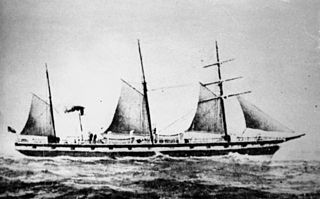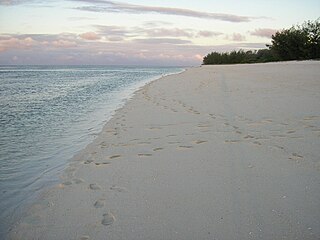Mersey was a ship launched at Chittagong in 1801 and wrecked in the Torres Strait, Australia, about mid-June 1804. She was the first merchantman lost in the Strait.
Sir Charles Hardy Islands is in the reef of the same name adjacent to Pollard Channel & Blackwood Channel about 40 km east of Cape Grenville off Cape York Peninsula.

Cato was launched at Stockton in 1800 and registered in London to Reeve & Green. She was wrecked on the Great Barrier Reef, Australia, in 1803 at.

SS Gothenburg was an iron-hulled sail- and steamship that was built in England in 1854 and sailed between England and Sweden until 1862. She then moved to Australia, where she operated across the Tasman Sea to and from New Zealand until 1873, when she was rebuilt. After her rebuild, she operated in the Australian coastal trade.
Campbell Macquarie was a ship that Joseph Underwood, a Sydney merchant, purchased at Calcutta in 1810. She appears, with Richard Siddins, master, in a list of vessels registered at Calcutta in 1811. She was wrecked near Macquarie Island in 1812.
Morning Star was launched at Calcutta, India, in 1813. She was wrecked on a coral reef south of Forbes Island, north Queensland in July 1814.
Trial was a ship that first appears in 1808 and that was seized by convicts and eventually wrecked on the Mid North Coast of New South Wales, Australia in 1816.
Lady Elliot was a ship that was probably wrecked off the coast near Cardwell, Queensland, Australia in 1816. It was a ship of 353 tons and had been constructed in Bengal, India, completed in 1815.

Saumarez Reef is one of the southernmost reefs to be located in the Coral Sea Islands and part of the Coral Sea Shelf; it contains three main reefs and numerous smaller reefs all of which form a large crescent-shaped formation open to the northwest, about 27 by 14 km, area less than 300 km2.

The Wreck Reefs are located in the southern part of the Coral Sea Islands approximately 450 kilometres (280 mi) east-north-east of Gladstone, Queensland, Australia.
The Earl of Charlemont was a medium-sized, 878 ton passenger ship, which sank on a voyage to Australia.
Wreck Island is a small coral cay. It is located near the Tropic of Capricorn in the southern Great Barrier Reef, 93 km due north east of Gladstone, Queensland, Australia, and 460 km north of the state capital Brisbane.

HMS Porpoise was a 12-gun sloop-of-war originally built in Bilbao, Spain, as the packet ship Infanta Amelia. On 6 August 1799 HMS Argo captured her off the coast of Portugal. Porpoise wrecked in 1803 on the North coast of what was then part of the Colony of New South Wales, now called Wreck Reefs, off the coast of Queensland, Australia.
Admiral Gifford was a wooden schooner that was lost while travelling between Port Macquarie and Sydney, New South Wales, on 8 October 1834 with a cargo of grain, hides and tallow.

Masthead Island is a coral cay located in the southern Great Barrier Reef, 60 kilometres northeast of Gladstone, Queensland. The island is a protected area and forms part of Capricornia Cays National Park. Masthead Island is one of the most undisturbed cays in the national park because human and feral animal impacts have been rare. The cay covers an area of 0.45 square kilometres (0.17 sq mi) and is surrounded by a coral reef that is partially exposed at low-tide. It is part of the Capricornia Cays Important Bird Area.
Sun was a brig built in 1819 at Sunderland and was condemned at the Cape of Good Hope in August 1822. She was repaired and began sailing east of the Cape. She was wrecked in May 1826 in the Torres Strait.
Royal Charlotte was a three-masted merchant ship launched in 1819. Royal Charlotte carried convicts to Australia in 1825. On her way home to India via Batavia she wrecked on 11 June, but with minimal loss of life.

HMS Mermaid was a cutter built in Howrah, India, in 1816. The British Royal Navy purchased her at Port Jackson in 1817. The Navy then used her to survey the Australian coasts. In 1820 she grounded and in 1823 was condemned for survey work. The Navy sold her to the colonial government which used her to run errands until she was wrecked in 1829.
Prince Blucher was launched at Chittagong in 1815. She made one voyage for the British East India Company. She participated in two and possibly three rescues, one particularly notable, and was wrecked in 1821. Condemned, she was laid up and later broken up in 1824.
Greyhound was launched at Java in 1816. She burnt there in 1821.





